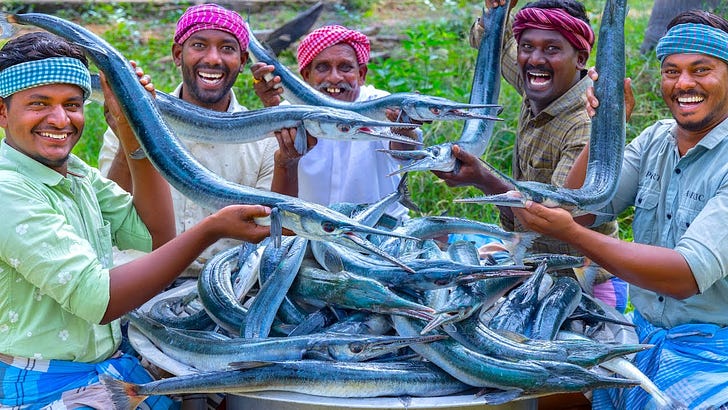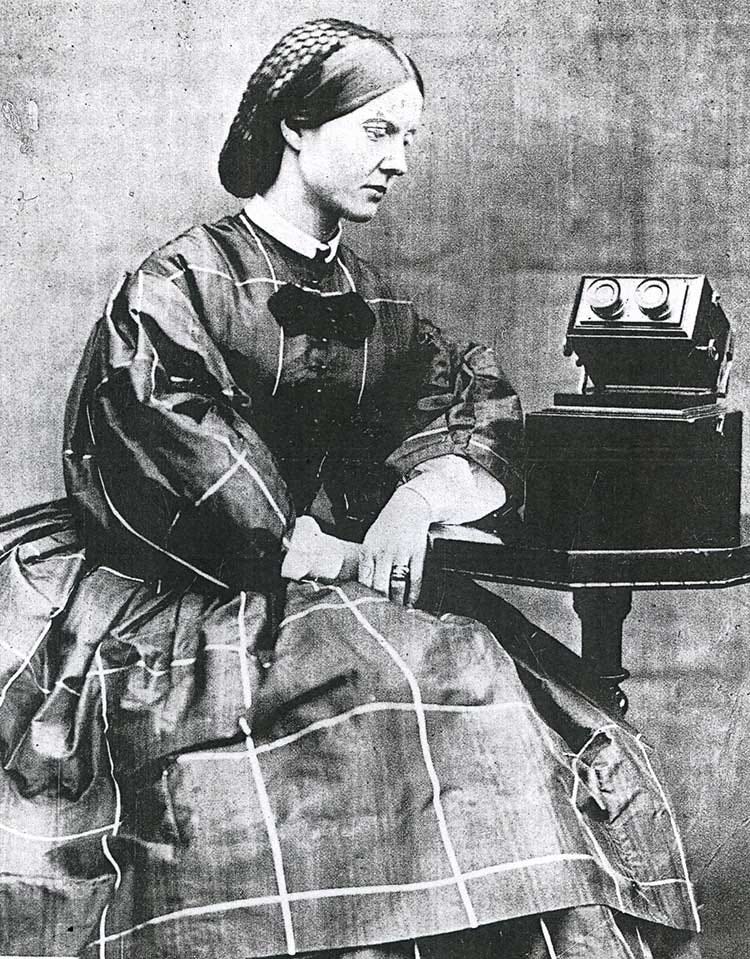#4 Green bones and an accident
Numbers. You understand what they stand for. But what exact number comes to your mind when I say “few” or “some” or “many” or “several”? What’s your cut off for “few”? What’s the minimum number for “many”? I often think about this when writing—does my “many” match the reader’s “many”? Or are we all concocting our own stories as we read, my brain imagining 10 dogs on a road, you imagining 50? Anyway, I’m curious about what you think, so let me know in an email or a comment here.
Now, for the latest rabbit hole dives.
Green Bones
Have you watched the Village Cooking Channel on Youtube? It’s where a grandfather and a bunch of brothers make cooking videos in the farms of a place called Chinnaveeramangalam in Tamil Nadu. If you haven’t, you should definitely check them out.
Yesterday, I was watching them cook 100 kilos of garfish. It’s a kind of needlefish, with a long, slender body and a needle-like snout, found in the deep-sea. I’ve seen heaps of this fish being sold in the fish markets of Chennai. [I did a story from that visit, if you’re interested].
In the video, as the cooks started chopping the fish, I noticed something: the teeth of the fish were a shiny bluish-green. So were the bones. Also, the scales, when the light hit them at a certain angle. I had never seen blue-green bones in a fish, so this turned into a learning moment.
A quick search on Google scholar showed me that some scientists have tried to find out what gives garfish bones/scales/teeth their bluish green colour. And they’ve concluded that it’s a pigment called Biliverdin. We all have it.
In humans, the iron content in hemoglobin is what gives our red blood cells a reddish colour. Our red blood cells die every 4 months or so. And as the old RBCs breakdown, hemoglobin breaks down further to form the green pigment biliverdin. Biliverdin goes on to break down some more to form the yellow pigment bilirubin. Those green and yellow colours in bruises that you sometimes see are due to these pigments. [next time you get a bruise, watch out for the two Bilis].
All the biliverdin and bilirubin circulating in our blood are cleared by the liver (which is why when the liver doesn’t function as it should, these pigments accumulate in the blood, bringing about the typical yellowish colour associated with jaundice). For us, greens and yellows are a sign that something’s not right in the body. Both pigments at high concentrations are in fact thought to be toxic.
So, why are the garfish so green then? I couldn’t find that answer. But I did find other animals that have similar traits.
A group of lizards that live in New Guinea and the Solomon Islands have green bones, muscles and blood. Again, scientists have shown that this is because they have a lot of biliverdin circulating in the blood. There’s so much biliverdin that its green overshadows hemoglobin’s red.
Again, people haven’t figured out why these lizards have green bones and blood. But there must be some evolutionary advantage to having these otherwise “toxic” pigments accumulate. In the lizards’ case, scientists speculate the lizards went about concentrating biliverdin in their blood to ward off malaria parasites that are prevalent in the region. But what about the garfish? I don’t know yet.
If you’re aware of any studies or have any idea, let me know!
An accident
(Trigger warning: Description of road accidents.)
When my mom was a child, she was in a major accident. The car she was in rammed into a tree, and she spent the next six months in a hospital getting her thigh bone fixed. The other day when we were talking about it, for the millionth time, I had a rather morbid thought — who was the first car accident victim? Do we know? It seems, we do.
One of the earliest recorded car accidents involved a rather interesting woman. Mary Ward.
Born into a rich family in Ireland in 1827, Mary wasn’t sent to a school, unlike her brother. Most girls wouldn’t at the time. So, Mary and her sisters were taught basic reading and skills at home by a governess. But Mary had access to scientists thanks to her family and she was a curious child, spending her days observing and sketching things around her.
She was particularly interested in insects — she would use a handheld magnifying lens to study their details, then carefully sketch them out. British astronomer James South, who eventually became the joint founder of the Astronomical Society of London, saw Mary’s work and asked her father to get her a microscope. In those days, microscopes were very expensive, but her dad could afford one. That was the start of Mary’s journey as a scientist-illustrator-naturalist.
She learned everything she could about how to use a microscope, from anyone and anything that would teach her. She also learned how to make specimens on her own, and slides of her own. She didn’t just stop at that. She published all of her learnings and sketches of her observations in several books on microscopy. You can find one of the editions on Flipkart. She was also a keen amateur astronomer, and would spend time making incredibly detailed drawings of celestial bodies. She wrote another book on Telescope Teachings— on how to best use a telescope. Basically, she was a super achiever in an era where girls weren’t encouraged to go to school and there was no internet.
Now, the incident.
As I’d mentioned, Mary had access to scientists of various kinds. Some were family friends. Others were part of her family. For instance, one of her cousins, William Parsons, 3rd Earl of Rosse, built a massive, 72 inch telescope in the grounds of Birr Castle, where they lived. It remained the world’s largest reflecting telescope until 1917. [Fun fact — the telescope wasn’t maintained well, and fell into a state of disrepair. A renovation programme restored it, thanks to the sketches that Mary had made while the telescope was being constructed].
William and his sons had also built a steam engine car in the family’s engineering workshop. On 31 August 1869, Mary and her husband, decided to go on a ride in the car along with some of the Parsons. The vehicle wasn’t moving fast, but when it turned a corner, it seems that Mary was thrown from her seat onto the road. I won’t get into the details, but she died from the impact of the vehicle’s wheel.
It’s speculated that the family was so upset that they immediately tore down the steam car and buried somewhere in Birr Castle.
On the internet, Mary Ward has become trivia — known more for being the first recorded car accident victim than her work. But reading about all that she managed to accomplish has frankly blown my mind. And she did that as the mother of 7 children (plus a few miscarriages), taking care of the family during the day and working on her interests at night. [One of her granddaughters is the British actress Lalla Ward, who played the role of Romana in Doctor Who.]
It’s these stories of accidents that give me pause every time I have to drive my car. It’s liberating to be a woman driving on Indian roads. It’s also fascinating the way humans can navigate traffic and a hundred other stimuli while moving at high speeds. At the same time, the machine’s sheer force combined with human fallibility makes me very uncomfortable.
On that note, see you next week. Thanks for reading!
Subscribe if you want the newsletters delivered to your inbox. If you want to talk to me about anything at all, follow me on Twitter @ShreyaDasgupta. Or send me an email: shreya.dg [at] gmail.com



